
Tripe is a type of edible lining from the stomachs of various farm animals. Most tripe is from cattle, pigs and sheep.
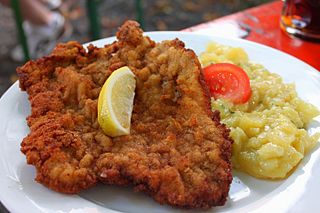
A schnitzel is a thin slice of meat. The meat is usually thinned by pounding with a meat tenderizer. Most commonly, the meat is breaded before frying. Breaded schnitzel is popular in many countries and is made using veal, pork, chicken, mutton, beef, or turkey. Schnitzel is very similar to the dish escalope in France and Spain, panado in Portugal, tonkatsu in Japan, cotoletta in Italy, kotlet schabowy in Poland, milanesa in Latin America, chuleta valluna in Colombia, and chicken-fried steak and pork tenderloin of the United States.
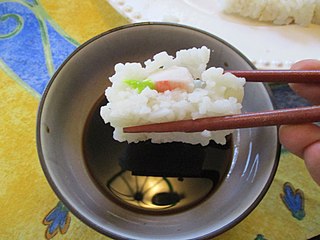
A dip or dipping sauce is a common condiment for many types of food. Dips are used to add flavor or texture to a food, such as pita bread, dumplings, crackers, chopped raw vegetables, fruits, seafood, cubed pieces of meat and cheese, potato chips, tortilla chips, falafel, and sometimes even whole sandwiches in the case of jus. Unlike other sauces, instead of applying the sauce to the food, the food is typically placed or dipped into the sauce.

Salvadoran cuisine is a style of cooking derived from the nation of El Salvador. The indigenous foods consist of a mix of Native American cuisine from groups such as the Lenca, Pipil, Maya Poqomam, Maya Chʼortiʼ, Alaguilac, Mixe, and Cacaopera peoples. Many of the dishes are made with maize (corn). There is also heavy use of pork and seafood. Eurasian ingredients were incorporated after the Spanish conquest.
Peruvian cuisine reflects local practices and ingredients including influences mainly from the indigenous population, including the Inca, and cuisines brought by immigrants from Europe, Asia, and Africa. Without the familiar ingredients from their home countries, immigrants modified their traditional cuisines by using ingredients available in Peru.

New Mexican cuisine is the cuisine of the Southwestern US state of New Mexico. The region is primarily known for its fusion of Pueblo Native American cuisine with Hispano Spanish and Mexican cuisine originating in Nuevo México.

Sofrito, sofregit (Catalan), soffritto, or refogado is a basic preparation in Mediterranean, Latin American, Spanish, Italian and Portuguese cooking. It typically consists of aromatic ingredients cut into small pieces and sautéed or braised in cooking oil.

Noodle soup refers to a variety of soups with noodles and other ingredients served in a light broth. Noodle soup is a common dish across East Asia, Southeast Asia and the Himalayan states of South Asia. Various types of noodles are used, such as rice noodles, wheat noodles and egg noodles.

Anticuchos are popular and inexpensive meat dishes that originated in the Andes during the pre-Columbian era, specifically in the Antisuyu region of the Tawantinsuyu. The modern dish was adapted during the colonial era between the 16th and 19th centuries and can now be found in Peru.

Peruvians are the citizens of Peru. There were Andean and coastal ancient civilizations like Caral, which inhabited what is now Peruvian territory for several millennia before the Spanish conquest in the 16th century; Peruvian population decreased from an estimated 5–9 million in the 1520s to around 600,000 in 1620 mainly because of infectious diseases carried by the Spanish. Spaniards and Africans arrived in large numbers in 1532 under colonial rule, mixing widely with each other and with Native Peruvians. During the Republic, there has been a gradual immigration of European people. Chinese and Japanese arrived in large numbers at the end of the 19th century.
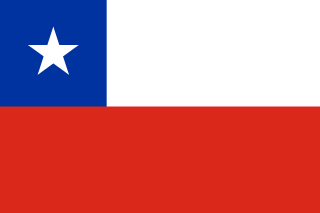
Chilean cuisine stems mainly from the combination of traditional Spanish cuisine, Chilean Mapuche culture and local ingredients, with later important influences from other European cuisines, particularly from Germany, the United Kingdom and France. The food tradition and recipes in Chile are notable for the variety of flavours and ingredients, with the country's diverse geography and climate hosting a wide range of agricultural produce, fruits and vegetables. The long coastline and the peoples' relationship with the Pacific Ocean add an immense array of seafood to Chilean cuisine, with the country's waters home to unique species of fish, molluscs, crustaceans and algae, thanks to the oxygen-rich water carried in by the Humboldt Current. Chile is also one of the world's largest producers of wine and many Chilean recipes are enhanced and accompanied by local wines. The confection dulce de leche was invented in Chile and is one of the country's most notable contributions to world cuisine.
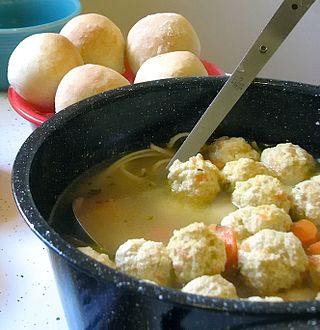
A meatball is ground meat rolled into a ball, sometimes along with other ingredients, such as bread crumbs, minced onion, eggs, butter, and seasoning. Meatballs are cooked by frying, baking, steaming, or braising in sauce. There are many types of meatballs using different types of meats and spices. The term is sometimes extended to meatless versions based on vegetables or fish; the latter are also commonly known as fishballs.
Arequipan cuisine is the cuisine of Arequipa, a regional Peruvian cuisine. Arequipan cuisine is known for its picanterías, traditional local restaurants offering chicha de jora accompanied by four small plates of spicy rocoto seasoned regional delicacies along with singing or music.

Chechen cuisine is the traditional folk cuisine of the Chechen people, who dwell in the North Caucasus.
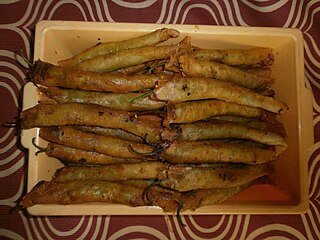
Dinamita is a deep-fried Filipino snack consisting of stuffed siling haba wrapped in a thin egg crêpe. The stuffing is usually giniling, cheese, or a combination of both but it can also be adapted to use a wide variety of ingredients, including tocino, ham, bacon, tuna, and shredded chicken. Dinamita is also known as dynamite lumpia, among other names. It is a type of lumpia and it is commonly eaten as an appetizer or as a companion to beer.
















